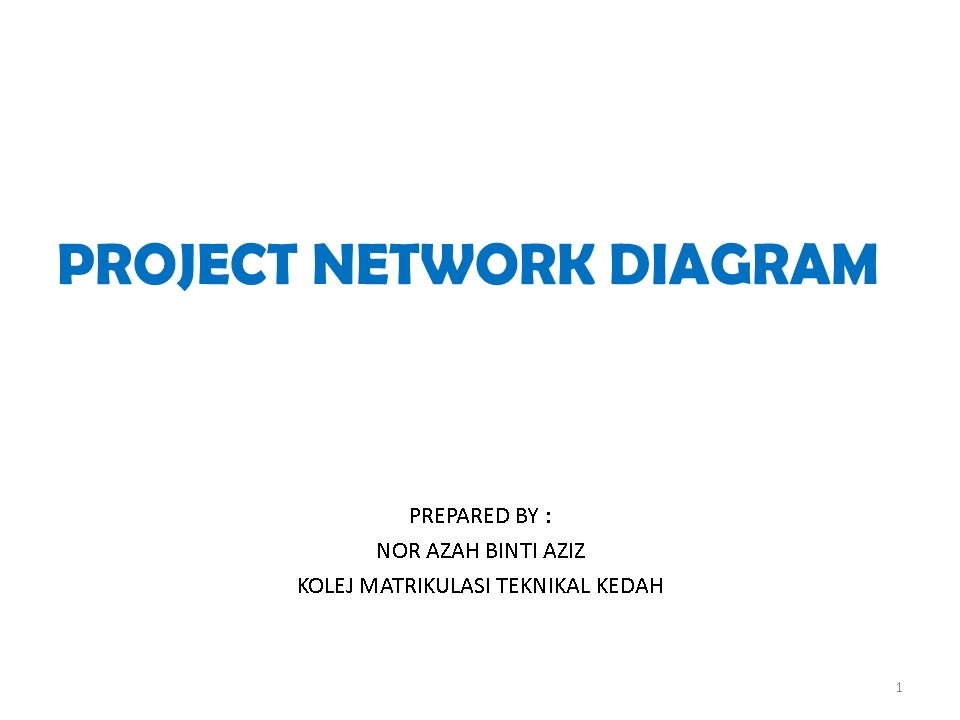PROJECT NETWORK DIAGRAM - PowerPoint PPT Presentation
Title:
PROJECT NETWORK DIAGRAM
Description:
PROJECT NETWORK DIAGRAM PREPARED BY : NOR AZAH BINTI AZIZ KOLEJ MATRIKULASI TEKNIKAL KEDAH * OBJECTIVES Define Network Diagram Purpose of Network Diagram Method ... – PowerPoint PPT presentation
Number of Views:768
Avg rating:3.0/5.0
Title: PROJECT NETWORK DIAGRAM
1
PROJECT NETWORK DIAGRAM
- PREPARED BY
- NOR AZAH BINTI AZIZ
- KOLEJ MATRIKULASI TEKNIKAL KEDAH
2
OBJECTIVES
- Define Network Diagram
- Purpose of Network Diagram
- Method Activity On the Node (AON)
- Identify ES, EF, LS, LF using Forward Pass
Calculation and Backward Pass calculation - Identify Critical Path
- Identify Slack Time
3
INTRODUCTION
- A PND is a pictorial representation of the
sequence in which the project work can be done. - The activities and its duration are the basic
building blocks needed to construct a graphic
picture of the project - Its provide
- - the earliest time at which work can be begin
on every activity that makes up the project - - the earliest expected completion date of the
project
4
IMPORTANCE OF ND
- ND can be used for
- i) Planning gives a clear graphical picture of
- the relationship between project activities
- ii) Implementation when updating the project
file with activity status and estimate to
completion data, the ND is then automatically
updated and can be printed or viewed - iii) control while updated ND will retain the
status of all activities, the best graphical
report and controlling project work will be
Gantt Chart
5
METHODS
- THE ACTIVITY ON THE NODE ( AON)
- Basic unit of analysis in ND is the activity
- Each activity is represented by a rectangle (
activity node) - Arrows represent the predecessor/successor
relationship between activities - Every activity in the project will have its own
activity node ( each rectangle)
6
METHODS
- THE ACTIVITY ON THE NODE ( AON)
7
METHODS
- THE ACTIVITY ON THE NODE ( AON)
- Dependencies
- A dependency is simply a relationship that exists
between pairs of activities - 4 types of activity dependencies
FS A finishes, B start
8
METHODS
- THE ACTIVITY ON THE NODE ( AON)
- Dependencies
FF A finishes, B finish
SS A start, B start
9
METHODS
- THE ACTIVITY ON THE NODE ( AON)
- Dependencies
SF A starts, B finish
10
- THE ACTIVITY ON THE NODE ( AON)
11
- THE ACTIVITY ON THE NODE ( AON)
Creating an initial project network schedule
Forward Pass calculations
12
EST, LST, EFT, LFT
- CPM uses the following times for an activity
- EST - Early Start time is the earliest time the
activity - can begin
- LST - Late Start Time is the latest time the
activity can begin - - still allow the project to be completed on
time - EFT - Early Finish Time is the latest time the
activity can end - LFT - Late Finish Time is the latest time the
activity can end - - still allow the project to be completed on
time
13
Forward Pass calculations
14
Backward Pass calculations
15
CRITICAL PATH METHOD (CPM)
- An effective way to analyze complex projects
- Represent the critical set of activities to
complete a project - Help to focus on essential activities which are
critical to run the project - Allows the project manager to concentrate on
important activities - CP is the longest path on ND and the most
important part - Any delays on the CP will lead to delay of the
project
16
CRITICAL PATH METHOD (CPM)
17
FLOAT
- Also known as slack, total float and path float
- Is computed for each task by subtracting EFT from
the LFT - ( _at_ the early start from the late start)
- Is the amount of time the task can slip without
- delaying the project finish date.
- Free float is the amount of time a task can slip
- without delaying the early start of any task
- that immediately follows it.
18
Slack Time calculations
19
EXAMPLE
1. TABLE 1 shows the activities and the
durations required to complete a construction
project, including the precursor activity.
Refering to the TABLE 1 i) draw the
project network diagram. ii)
state the activities on the critical path. iii)
calculate the minimum duration of the
project.
Activity Precursor Duration (week)
A - 7
B A 6
C A 5
D A,B 4
E B,C 3
F D,E 2
20
project network diagram































